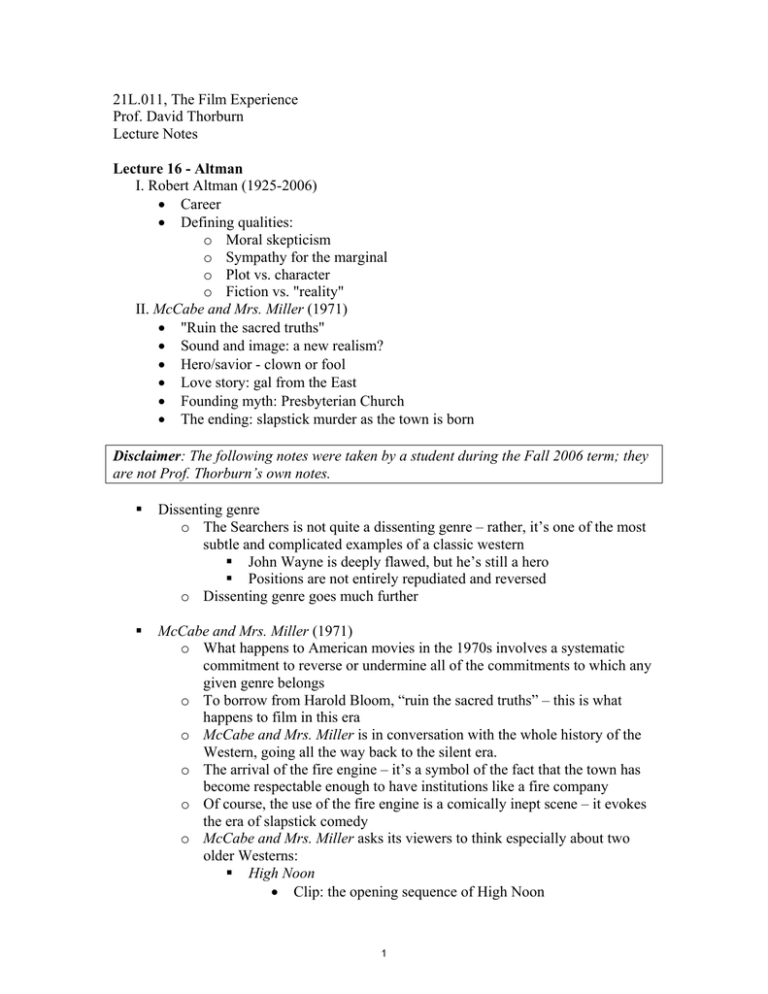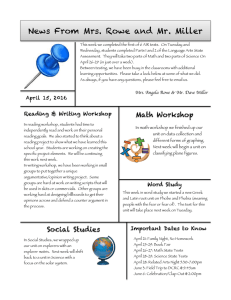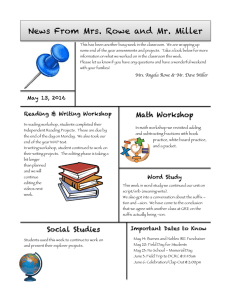Document 12689322
advertisement

21L.011, The Film Experience Prof. David Thorburn Lecture Notes Lecture 16 - Altman I. Robert Altman (1925-2006) Career Defining qualities: o Moral skepticism o Sympathy for the marginal o Plot vs. character o Fiction vs. "reality" II. McCabe and Mrs. Miller (1971) "Ruin the sacred truths" Sound and image: a new realism? Hero/savior - clown or fool Love story: gal from the East Founding myth: Presbyterian Church The ending: slapstick murder as the town is born Disclaimer: The following notes were taken by a student during the Fall 2006 term; they are not Prof. Thorburn’s own notes. Dissenting genre o The Searchers is not quite a dissenting genre – rather, it’s one of the most subtle and complicated examples of a classic western John Wayne is deeply flawed, but he’s still a hero Positions are not entirely repudiated and reversed o Dissenting genre goes much further McCabe and Mrs. Miller (1971) o What happens to American movies in the 1970s involves a systematic commitment to reverse or undermine all of the commitments to which any given genre belongs o To borrow from Harold Bloom, “ruin the sacred truths” – this is what happens to film in this era o McCabe and Mrs. Miller is in conversation with the whole history of the Western, going all the way back to the silent era. o The arrival of the fire engine – it’s a symbol of the fact that the town has become respectable enough to have institutions like a fire company o Of course, the use of the fire engine is a comically inept scene – it evokes the era of slapstick comedy o McCabe and Mrs. Miller asks its viewers to think especially about two older Westerns: High Noon Clip: the opening sequence of High Noon 1 o o o o o o o o o Note that it begins with a ballad, like many Westerns Note that the bad guys are marked by their dark appearance, their uncleanliness, and their evil expressions The hero has to fight them alone – what allows him to survive is in part his greater knowledge of the physical geography of the town o This same pattern is clearly present at the end of McCabe and Mrs. Miller Note that our introduction to the town comes via church bells and the appearance of the church My Darling Clementine The central energies of this film are very close to those of McCabe and Mrs. Miller – except that they’re the obverse of each other The classic Western is always about the creation of a civilized community out of a savage and chaotic wilderness The looming rock formations of John Ford’s setting suggests the smallness of human endeavors The hero kills with impunity, but he’s nervous around women Notice the flags – there’s always an implicit patriotism in classic Westerns All of this is reenacted in McCabe and Mrs. Miller, but exposed to a terrible irony and skepticism It’s a color film, but it doesn’t have much color There’s the sense that the weather really matters, as the snow piles up higher and higher in the snow storm, it’s important, and related to the terrible killing sequence Altman calls our attention to ambient sound The classic hero or savior figure is a kind of silly clown or fool – he’s terribly easy to manipulate The heroine has come from England to be a madam, a manager of whores She’s much more intelligent than McCabe, but because she’s a woman there are limits to what she can do This is a sort of commentary The town grows on the periphery of the film – even though it’s always going on, you’re not aware of it The barber is black – in St. Louis he couldn’t work as a barber, but in this brand new town, everyone still has a chance, because there aren’t enough people In this way the town is made up of outcasts, who are limited in larger society because of prejudice or because of some other disability Altman likes shocking shootings, with bodies bleeding in the water For literate readers of the Western, this has an absolute shock value, because it so completely reverses all their expectations 2 o In the classic Western, there is apocalyptic violence, after which society is regenerated o In McCabe and Mrs. Miller, you see this violence with McCabe trying to save his own life, inter-cut with the slapstick scene of people trying to put out the church fire o Every element of the classic Western is mocked and turned upside down in this manner in McCabe and Mrs. Miller 3 MIT OpenCourseWare http://ocw.mit.edu 21L.011 The Film Experience Fall 2012 For information about citing these materials or our Terms of Use, visit: http://ocw.mit.edu/terms.







